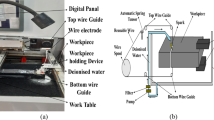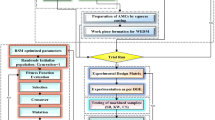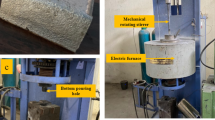Abstract
Peculiar characteristics of squeeze casted hybrid aluminum matrix composites (AMCs) enable it as an appropriate candidate for various manufacturing applications but also make their machining challenging. For that reason, wire electric discharge machining (WEDM) has been preferred over conventional machining processes for the cutting squeeze casted Al2024/Al2O3/W hybrid composite in this study. The presence of nanoparticles in the material affects the machining performance of wire electrodes. Therefore, molybdenum and zinc-coated wires have been chosen, and cryogenic treatment has been applied to improve their machining performance. To analyze the effects of cryogenic treatment, the machining efficiency of cryogenic treated (CT) wire has been compared with non-treated (NT) wire. Besides wire type, four key input variables including pulse duration (TON), wire feed rate (FR), wire runoff speed (SW), and wire tension (TW) have also been optimized to improve the imperative response measures including cutting speed (CS), surface roughness (SR), and kerf width (KW). Microstructural analysis of NT wire depicts a high concentration of micro-voids, micro-cracks, and deep craters, while the surface of CT wire has been observed relatively fine after the machining. Comparative analysis of both wire electrodes has declared that CT wire yields 26.96% and 15.10% superior results for CS and SR respectively, and 6.92% deprived results for KW than NT wire. Grey relational analysis (GRA) has been practiced for multi-objective optimization and presented TON = 3 μs, FR = 13 m/min, SW = 11 m/min, and TW = 10 g as an optimal set of input variables to achieve 75.1% and 72.5% overall results with NT and CT wire, respectively.













Similar content being viewed by others
Change history
05 January 2024
A Correction to this paper has been published: https://doi.org/10.1007/s00170-024-12986-1
Abbreviations
- WEDM:
-
Wire electric discharge machining
- AMC:
-
Aluminum matrix composite
- TON :
-
Pulse duration
- FR :
-
Wire feed rate
- SW :
-
Wire runoff speed
- TW :
-
Wire tension
- TOFF :
-
Pulse off time
- CS :
-
Cutting speed
- SR :
-
Surface roughness
- KW :
-
Kerf width
- I:
-
Discharge current
- V:
-
Gap voltage
- SEM:
-
Scanning electron microscope
- CT wire:
-
Cryogenic treated zinc-coated brass wire
- NT wire:
-
Non-cryogenic treated zinc-coated brass wire
- UTS:
-
Ultimate tensile strength
- RSM:
-
Response surface methodology
- ANOVA:
-
Analysis of variance
- GRA:
-
Grey relational analysis
- GRG:
-
Grey relational grade
References
Pramanik A (2016) Effects of reinforcement on wear resistance of aluminum matrix composites. Trans Nonferrous Metals Soc China 26(2):348–358
Dinaharan I et al (2016) Microstructure and wear characterization of aluminum matrix composites reinforced with industrial waste fly ash particulates synthesized by friction stir processing. Mater Charact 118:149–158
Lu T et al (2020) Microstructure, mechanical properties and machinability of particulate reinforced Al matrix composites: a comparative study between SiC particles and high-entropy alloy particles. Journal of Materials Research and Technology 9(6):13646–13660
Zhang C et al (2017) Enhanced tensile properties of Al matrix composites reinforced with β-Si3N4 whiskers. Compos A: Appl Sci Manuf 102:145–153
Gebler, M., A.J.S. Uiterkamp, and C.J.E.P. Visser (2014) A global sustainability perspective on 3D printing technologies. 74: p. 158-167.
Idrisi AH, Mourad A-HI (2019) Conventional stir casting versus ultrasonic assisted stir casting process: mechanical and physical characteristics of AMCs. J Alloys Compd 805:502–508
Nemtajela N, Mbohwa C (2017) Relationship between inventory management and uncertain demand for fast moving consumer goods organisations. Procedia Manufacturing 8:699–706
Sarfraz MH et al (2019) Multi-response parametric optimization of squeeze casting process for fabricating Al 6061-SiC composite. Int J Adv Manuf Technol 102(1):759–773
Liao Z et al (2019) State-of-the-art of surface integrity in machining of metal matrix composites. Int J Mach Tools Manuf 143:63–91
Senthil P, Selvaraj T, Sivaprasad K (2013) Influence of turning parameters on the machinability of homogenized Al–Cu/TiB 2 in situ metal matrix composites. Int J Adv Manuf Technol 67(5-8):1589–1596
Bejjani R et al (2016) Chip formation and microstructure evolution in the adiabatic shear band when machining titanium metal matrix composites. Int J Mach Tools Manuf 109:137–146
Pugazhenthi A et al (2018) Turning characteristics of in situ formed TiB2 ceramic particulate reinforced AA7075 aluminum matrix composites using polycrystalline diamond cutting tool. Measurement 121:39–46
Dandekar CR, Shin YC (2012) Modeling of machining of composite materials: a review. Int J Mach Tools Manuf 57:102–121
Nicholls CJ et al (2017) Review of machining metal matrix composites. Int J Adv Manuf Technol 90(9-12):2429–2441
Raju R et al (2018) Optimization of process parameters in electrical discharge machining of haste alloy C276 using Taguchi’s method. Materials Today: Proceedings 5(6, Part 2):14432–14439
Reolon LW et al (2019) WEDM performance and surface integrity of Inconel alloy IN718 with coated and uncoated wires. Int J Adv Manuf Technol 100(5-8):1981–1991
Tahir W, Jahanzaib M (2019) Multi-objective optimization of WEDM using cold treated brass wire for HSLA hardened steel. J Braz Soc Mech Sci Eng 41(11):525
Gong Y et al (2017) Experimental study on surface integrity of Ti-6Al-4V machined by LS-WEDM. Int J Adv Manuf Technol 88(1):197–207
Paswan K, Pramanik A, Chattopadhyaya S (2020) Machining performance of Inconel 718 using graphene nanofluid in EDM. Mater Manuf Process 35(1):33–42
Muniappan A et al (2019) Optimization of WEDM process parameters for cutting speed using Taguchi technique. Materials Today: Proceedings 18:332–341
Satishkumar D, Kanthababu M (2014) Optimization of Wedm parameters for surface roughness on hybrid Mmcs. Adv Compos Lett 23(3):096369351402300303
Ugrasen G et al (2018) Estimation of machining performances using MRA and GMDH in wire EDM of Al2024 based hybrid MMC. Materials Today: Proceedings 5(1, Part 3):3084–3092
Nag A et al (2018) Surface integrity analysis of wire-EDM on in-situ hybrid composite A359/Al2O3/B4C. Materials Today: Proceedings 5(11, Part 3):24632–24641
Kumar SS et al (2015) Parametric optimization of wire electrical discharge machining on aluminium based composites through grey relational analysis. J Manuf Process 20:33–39
Udaya Prakash J et al (2018) Optimization of wire EDM process parameters for machining hybrid composites (356/B4C/Fly Ash) using Taguchi technique. Materials Today: Proceedings 5(2, Part 2):7275–7283
Lal S et al (2014) Wire electrical discharge machining of AA7075/SiC/Al2O3 hybrid composite fabricated by inert gas-assisted electromagnetic stir-casting process. J Braz Soc Mech Sci Eng 36(2):335–346
Ishfaq, K., et al. (2020) Optimization of WEDM for precise machining of novel developed Al6061-7.5% SiC squeeze-casted composite. The International Journal of Advanced Manufacturing Technology.
Tahir W, Jahanzaib M, Raza A (2019) Effect of process parameters on cutting speed of wire EDM process in machining HSLA steel with cryogenic treated brass wire. Advances in Production Engineering & Management 14(2):143–152
Goyal A (2017) Investigation of material removal rate and surface roughness during wire electrical discharge machining (WEDM) of Inconel 625 super alloy by cryogenic treated tool electrode. Journal of King Saud University-Science 29(4):528–535
Özbek NA et al (2014) Investigation of the effects of cryogenic treatment applied at different holding times to cemented carbide inserts on tool wear. Int J Mach Tools Manuf 86:34–43
Yao Y, Zhou Y (2018) Effects of deep cryogenic treatment on wear resistance and structure of GB 35CrMoV steel. Metals 8(7):502
Senthilkumar D, Rajendran I (2012) Optimization of deep cryogenic treatment to reduce wear loss of 4140 steel. Mater Manuf Process 27(5):567–572
Seah K, Rahman M, Yong K (2003) Performance evaluation of cryogenically treated tungsten carbide cutting tool inserts. Proc Inst Mech Eng B J Eng Manuf 217(1):29–43
Kapoor J, Khamba JS, Singh S (2012) Effect of shallow cryogenic treated brass wire electrode on workpiece surface roughness in wire-EDM. International Journal of Materials Engineering Innovation 3(3-4):190–203
Kapoor J, Singh S, Khamba JS (2012) Effect of cryogenic treated brass wire electrode on material removal rate in wire electrical discharge machining. Proc Inst Mech Eng C J Mech Eng Sci 226(11):2750–2758
Nayak BB, Mahapatra SS (2016) Optimization of WEDM process parameters using deep cryo-treated Inconel 718 as work material. Engineering Science and Technology, an International Journal 19(1):161–170
Raza MH et al (2018) Investigating the effects of different electrodes on Al6061-SiC-7.5 wt% during electric discharge machining. Int J Adv Manuf Technol 99(9):3017–3034
Kapoor J, Singh S, J.S.J.P.o.t.I.o.M.E. Khamba (2012) Effect of cryogenic treated brass wire electrode on material removal rate in wire electrical discharge machining. Part C: Journal of Mechanical Engineering Science 226(11):2750–2758
Beutel A-L, Minner S (2012) Safety stock planning under causal demand forecasting. Int J Prod Econ 140(2):637–645
Murr, L. and S.J.C.M.P. Gaytan (2014) Advances in additive manufacturing and tooling, Elsevier. p. 135-161.
Spoerk, M., C. Holzer, and J. Gonzalez-Gutierrez (2020) Material extrusion-based additive manufacturing of polypropylene: a review on how to improve dimensional inaccuracy and warpage. 137(12): p. 48545.
de Kok T et al (2018) A typology and literature review on stochastic multi-echelon inventory models. Eur J Oper Res 269(3):955–983
Patel GC, Shettigar MAK, Parappagoudar MB (2018) A systematic approach to model and optimize wear behaviour of castings produced by squeeze casting process. J Manuf Process 32:199–212
Luo, R.C., C.H. Hsu, and Y.C. Wen (2020) Multi-model fusion on real-time drowsiness detection for telemetric robotics tracking applications. in 2020 International Conference on Advanced Robotics and Intelligent Systems (ARIS).
Montgomery, D.C. (2017) Design and analysis of experiments: John wiley & sons.
Ali MA et al (2018) Evaluating the effects of as-casted and aged overcasting of Al-Al joints. Int J Adv Manuf Technol 96(1):1377–1392
Kavimani V, Prakash KS, Thankachan T (2019) Multi-objective optimization in WEDM process of graphene–SiC-magnesium composite through hybrid techniques. Measurement 145:335–349
Gopal PM, Prakash KS, Jayaraj S (2018) WEDM of Mg/CRT/BN composites: effect of materials and machining parameters. Mater Manuf Process 33(1):77–84
Rajmohan K, Kumar AS (2017) Experimental investigation and prediction of optimum process parameters of micro-wire-cut EDM of 2205 DSS. Int J Adv Manuf Technol 93(1-4):187–201
Habib S, Okada A (2016) Experimental investigation on wire vibration during fine wire electrical discharge machining process. Int J Adv Manuf Technol 84(9):2265–2276
Chen Z et al (2017) Theoretical and experimental study of magnetic-assisted finish cutting ferromagnetic material in WEDM. Int J Mach Tools Manuf 123:36–47
Manjaiah M et al (2015) Effect of electrode material in wire electro discharge machining characteristics of Ti50Ni50−xCux shape memory alloy. Precis Eng 41:68–77
Habib S (2017) Optimization of machining parameters and wire vibration in wire electrical discharge machining process. Mechanics of Advanced Materials and Modern Processes 3(1):3
Habib S, Okada A (2016) Study on the movement of wire electrode during fine wire electrical discharge machining process. J Mater Process Technol 227:147–152
Raza, M.H., et al. (2019) Grain selection and crystal orientation in single-crystal casting: state of the art. 54(2): p. 1800177.
Tahir, W., et al. (2019) Surface morphology evaluation of hardened HSLA steel using cryogenic-treated brass wire in WEDM process. 104(9-12): p. 4445-4455.
Krishnaiah, K. and P. Shahabudeen(2012) Applied design of experiments and Taguchi methods: PHI Learning Pvt. Ltd.
Raza MH et al (2019) Modeling of the mechanical properties of directionally solidified Al-4.3% Cu alloy using response surface methodology. Int J Adv Manuf Technol:1–13
Ali MA et al (2020) Mechanical characterization of aged AA2026-AA2026 overcast joints fabricated by squeeze casting. Int J Adv Manuf Technol:1–21
Leung WK, Raza MH, Zhong RY (2021) Optimization of support structure in multi-articulated joints of non-assembly mechanisms. Procedia CIRP 100:726–731
Yuan J et al (2008) Reliable multi-objective optimization of high-speed WEDM process based on Gaussian process regression. Int J Mach Tools Manuf 48(1):47–60
Ishfaq K et al (2019) Evaluating material’s interaction in wire electrical discharge machining of stainless steel (304) for simultaneous optimization of conflicting responses. Materials 12(12):1940
Wojciechowski S et al (2018) Application of signal to noise ratio and grey relational analysis to minimize forces and vibrations during precise ball end milling. Precis Eng 51:582–596
Funding
This research work was supported in part by the Seed Fund for Basic Research in HKU (Grant No. 201906159001) and in part by ITF project (PRP/068/20LI).
Author information
Authors and Affiliations
Contributions
Conceptualization, Methodology, Writing original draft: Muhammad Huzaifa Raza. Conceptualization, Data curation, Investigation and visualization: Muhammad Asad Ali. Resources, Investigation and Experimentation: Waseem Tahir. Supervision, Review and editing: Ray Y. Zhong. Review and editing: Nadeem Ahmad Mufti, Naveed Ahmad.
Corresponding author
Ethics declarations
Ethics approval
Not applicable.
Consent to Participate
Not applicable.
Consent for Publication
Not applicable.
Competing interests
The authors declare no competing interests.
Additional information
Publisher’s note
Springer Nature remains neutral with regard to jurisdictional claims in published maps and institutional affiliations.
Rights and permissions
Springer Nature or its licensor (e.g. a society or other partner) holds exclusive rights to this article under a publishing agreement with the author(s) or other rightsholder(s); author self-archiving of the accepted manuscript version of this article is solely governed by the terms of such publishing agreement and applicable law.
About this article
Cite this article
Raza, M.H., Ali, M.A., Tahir, W. et al. Cryogenic treatment analysis of electrodes in wire electric discharge machining of squeeze casted Al2024/Al2O3/W composite. Int J Adv Manuf Technol 116, 1179–1198 (2021). https://doi.org/10.1007/s00170-021-07521-5
Received:
Accepted:
Published:
Issue Date:
DOI: https://doi.org/10.1007/s00170-021-07521-5




